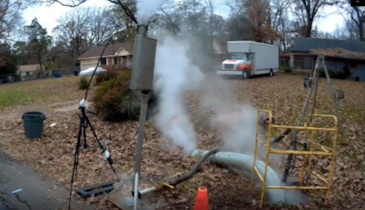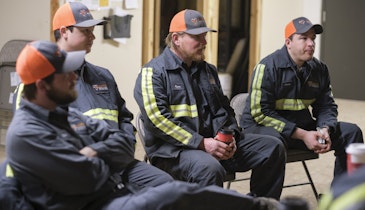Interested in Vacuum Excavation?
Get Vacuum Excavation articles, news and videos right in your inbox! Sign up now.
Vacuum Excavation + Get AlertsDon't let the “mini” label fool you. Vac-Tron Mini-Combo vacuum excavators offer owners and operators opportunities other machines don’t through a versatile combination of components and options that facilitate both hydro-jetting and excavation work in a single machine. And although the Vac-Tron Mini-Combo series of trailer vacuum excavators may have a more compact footprint compared to full-sized trucks or larger trailer-mounted systems, what they lack in physical size they make up for in versatility and performance, delivering productivity to smaller, space-restricted job sites that are often inaccessible with these machines’ larger counterparts.
The mighty mini
For a "mini" machine, the Mini-Combo series helps change how municipalities perform routine water and sewer maintenance work — along with a variety of other supplementary jobs they can be used for — in a more efficient and productive manner, according to Vermeer MV Solutions sales director Brian Showley.
Right now, most municipalities have larger jetter trucks in their fleets, but they’re typically reserved for bigger jobs for which they were designed. The efficiency and functionality of those larger units decline when deployed for smaller excavation, jetting and potholing work. Using a mini-combo machine instead helps maintain a high productivity for both machines by better matching their capabilities with the jobs for which they’re used.
“Many municipalities are starting to realize that, with the cost of operation, it doesn’t make sense to pull a large vacuum excavation truck off a larger project to work on a 4-inch lateral. If you have to pull it off a big job, you aren't getting the value from the machine," Showley says. "You can do that smaller job for a fraction of the cost and keep that big truck busy doing the jobs for which it was designed."
With their high onboard water capacity, the machines enable the operator to work longer hours without stopping to refill, a process that pauses revenue-generating work, sometimes for hours.
Choosing the right mini-combo
The combined sewer jetting and hydroexcavation capabilities make the mini-combo models ideal for a range of other excavation and potholing jobs. So, how do you know if a mini-combo machine is right for your fleet?
Showley recommends asking a few key questions if you’re considering adding a mini-combo vacuum excavator to your equipment lineup. Doing so can help zero in on both whether a system is right for you:
- What kind of excavation work do you do?
- Do you need to and/or want to add jetting and hydroexcavation capabilities?
- What other excavation services could you reasonably offer by adding these capabilities?
- What excavation equipment do you currently use and how do you use it?
- What are your limitations with your current equipment fleet?
- What kind of job site space restrictions do you encounter?
- Do you use and/or have access to a large jetter truck? If not, how are you responding to customer requests for work that requires this type of machine? If yes, are you renting it or do you own it?
Spec’d to get work done
Once you have answered the questions above, it is time to evaluate the models available. Vac-Tron offers three models — the 573 SDT, 873 SDT and 1273 SDT.
- The 573 SDT model offers a 300-gallonwater tank capacity and 500-gallon spoils tank capacity.
- The 873 SDT unit has a 400-gallon water tank and an 800-gallon spoils tank capacity.
- The 1273 SDT machine also has a 400-gallon water tank capacity with a higher 1,200-gallon spoils tank capacity.
All three models are engineered with a pump rated at 1,500 psi at 15 gallons per minute and a powertrain featuring a 74 hp engine. This powerful engine and pump combination enable these “mini” machines to clean lateral lines up to 12 inches in diameter and 500 feet in length.
Most important when looking at these specs is that you need to consider the size — length, width, height and weight — of these machines to best understand which unit to choose. Deemed “mini” because of their compact footprint compared to larger jetter trucks, they can fit into and onto narrower, tight-access jobsites. For comparison, the small 573 SDT model measures 253 inches in length, 100 inches in width and sits 91 inches high. Its total gross weight is 14,000 pounds.
The mid-sized 873 SDT unit measures 271 inches in length, 102 inches in width and sits 99 inches high. Its total gross weight is 20,000 pounds.
The larger 1273 SDT machine measures 265.5 inches in length, 102 inches in width and sits 122 inches high. Its total gross weight is 24,000 pounds.
Outfitted with options and accessories
Vac-Tron Mini-Combo vacuum excavators are engineered with a patented filtration system that includes a 0.5-micron filtration with a filter housing, as well as a four-way valve for reverse pressure and an oversized silencer for quiet operation. They also come standard with a jetter wheel and heavy-duty I-beam trailer.
These vacuum excavators come with choice of mechanically operated strong arms or hydraulic booms. Strong arms offer 270 degrees of rotation and is designed to support the weight of the vac hose and roller head, allowing for smooth, fluid movements and adjustments, but this option requires manual operation. The hydraulic boom option provides the operator with six-way functionality and 330 degrees of rotation — all with wireless, remote operation.
Vermeer MV Solutions regional sales manager Mike Spaulding says hydraulic booms enable a single operator to do the same work as two workers with other vacuum excavators. “With a strong arm, you have to have two workers, one with the 4-inch hose over their shoulder and the operator controlling it. The hydraulic boom allows the hose to rest in the boom, and with a remote, the operator can adjust and operate while they’re cutting. The operator can control that boom without absorbing so much of the impact with other systems using the handheld wireless remote controller, so they can operate from a distance if necessary.”
While the versatile hydraulic boom option does come with a higher price tag than the strong-arm choice, it can be offset in the right working situation on a range of jetting and excavation jobs.
“Preferences for options like the hydraulic boom depend on how the owner looks at their business. If they are going to have a large workforce on the job site, they may be less apt to pay for a hydraulic boom — opting instead for the mechanic strong arm configuration since they can put an extra worker on the job to help out.
“But, if it’s someone who’s having trouble finding the right labor,” Spaulding adds, “the hydraulic boom is a more attractive option so that extra worker doesn’t need to be there. If labor constrains your ability to dump and refill water tanks and you just have one worker to operate the machine, they can still be efficient with a hydraulic boom.”
Another hydraulic component of the Vermeer mini-combo machines is a rear door that enables the operator to efficiently clean out the tank when the job is complete.
These mighty mini-combo vacs can be used on a variety of job sites including general utility work, as well as niche plumbing, sewer and municipality projects. “There are so many applications for which these machines work so well, and so many ways to save time on the job site. Contractors need to take all of this into account in determining how they can use a mini-combo vac,” Spaulding says.
For information about the mini-combo vacuum excavator, contact your local Vermeer dealer to learn more about how you can put one to work in your business.






